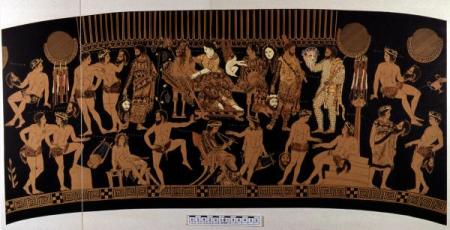I have not been able to find much, but I managed to get access to an online version of the Oxford Classical Dictionary. Although there is no specific date for the beginning of "new music," this entry seems to me to create a beginning date of about 430, but this is just an estimate from the names on the list and their careers. Other than the transliterated Greek words, all italics are mine (in order to establish emphasis on the particular sections that are important).
"Choral lyric, an indissoluble blend of poetry, melody, accompaniment and, dance, was already an admired art in the 7th cent., notably in Sparta and at the Delian festivals; competition was endemic and essential in this genre too (see particularly Alcman fr. 1 Poetae Melici Graeci, and the Homeric Hymn to Apollo). We hear of many types: the story of the two that later achieved highest status, dithyramb and tragedy , cannot be retold here. Both originated in the singing and dancing of choruses to the auloi, which always remained the accompanying instrument: the dialogue of drama perhaps grew out of interchanges between the chorus and its leader. Other choral genres, such as paeans, maiden-songs, and victory-songs, were often accompanied by a kithara, sometimes by aulos and kithara together (but the question whether Pindar's victory-songs were indeed choral, or were solo pieces prefacing choral singing, is now the subject of lively dispute). Poet-composers of the late 6th and early 5th cents.— Lasus , Pratinas , Pindar , Simonides , and others—were often self-consciously reflective about their art: traces of various musical controversies survive, and Lasus is said to have written the first treatise on music. Pindar repeatedly proclaims himself a musical innovator (e.g. Olympian Odes 3. 4–6, fr. 61 B. Snell and H. Maehler ). But to moralists from Aristophanes (1) onwards, their period marks the pinnacle of the ancient, simple, educative, and edifying style: afterwards there is nothing but decline into theatricality and populism. As the 5th cent. progressed, melodies came to be embroidered with ornaments and turns, both in the vocal line and independently in its accompaniment. Modulations between scale-systems, facilitated by developments in instruments (more finger-holes on auloi, added strings on the kithera) became common, undermining old links between genre and musical structure. Traditionally distinct genres, such as kitharidia and choral dithyramb, began to merge into new and indeterminate forms. Technical expertise and startling dramatic effect were untiringly pursued: star instrumentalists and singers were idolized by the public, and like their modern counterparts enhanced their musical acts with striking costumes and histrionic bodily movements. Whereas previously the sense, rhythm, and cadence of the words had dictated their musical interpretation, now they were progressively subordinated to musical ideas worked out in their own terms and for their own sake. These developments spelled the downfall of an integrated art closely allied to religion and civic tradition; but it also meant the emancipation of pure music from ritual and, crucially, from poetry, which came gradually to be seen as a separate art. This musical revolution went hand in hand with the radical political and social changes of the later 5th cent., and with the individualistic, questioning modes of thought exemplified in the sophists and Socrates. The main names associated with it are Phrynis, Melanippides (2) , Cinesias , Philoxenus (1) , and especially Timotheus (1) : Cinesias and other purveyors of the ‘new music’, including Agathon and Euripides, are regularly pilloried by Aristophanes (1) . The Theban school of auletes (see Thebes (1) ), notably Pronomus and Antigenidas, achieved astonishing new levels of technical virtuosity and emotional expression.This evidence is problematic for the date of the that Zuckert proposes for Plato's Laws. However, this data is still inconclusive, as is the fact that Plato was talking about "new music" rather than some kind of precursor to that genre. Furthermore, if anyone has a anymore ideas about this, that would be lovely.
The new music met with resistance not only from Aristophanes and Plato. A 4th-cent. source paraphrased at [ Plutarch ] De musica 1137–8 lists a string of musicians who deliberately rejected the elaborate styles and theatrical tricks of Timotheus in favour of older and severer forms. But as always in musical history, the new music gradually became old hat. The subtle nuances of intonation and the complex modulations characteristic of Timothean music came to seem heavy and ‘classical’ in their turn, and were supplanted by straightforward diatonic progressions lightly flavoured with chromaticism." (Oxford Classical Dictionary, the entry on "music," section 4: history)
















